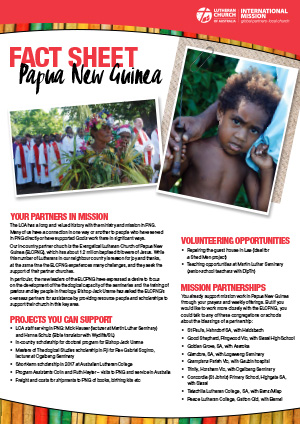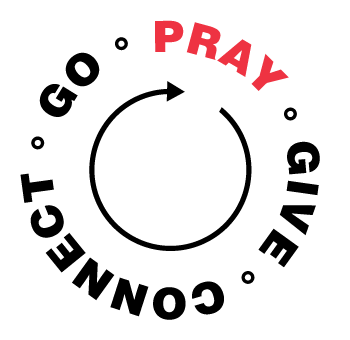Program history
The history of the Lutheran Church of Australia’s mission involvement in Papua New Guinea is long, complex and very detailed. Please read a condensed version below, with thanks to Lotte Hoopmann:
In the late 1800’s, the Western part of the island of New Guinea was taken over by Holland (later by Indonesia) and the North-Eastern area by Britain. This area became a German colony named Kaiser Wilhelmsland, and missionaries from the Neuendettelsau, Barmen and Rhenisch missions came from Germany to bring the Word to the natives, with Rev. Johannes Flierl, of Neuendettelsau, who arrived in Simbang on 12 July 1886 (via Australia), the first pioneer. While he was in Australia, Flierl was involved in mission work among the Australian Aborigines in central and far north Queensland. He also met and married Louise Auricht.
Mission stations were begun in the Finschhafen area, then Madang, Karkar and beyond. Because of the many challenges faced by the missionaries, the baptism of the first 2 natives was only in 1899. Due to World War I’s shortage of supplies and possible removal of the German missionaries (who were eventually allowed to remain in New Guinea as it was now an Australian Protectorate), the newly formed Australian United Evangelical Lutheran Church in Australia (UELCA) as well as the Iowa Synod of America, were contacted and eventually took over the administration of the field. Lutherans from the Evangelical Lutheran Church in Australia also served in large numbers. Australian Lutherans were involved in a vast array of tasks which supported the ‘missionary cause’, including pastors, teachers, deaconesses, mechanics, pilots, doctors, nurses, secretaries, accountants, builders … and a large number of volunteers who served in New Guinea for varying lengths of time and in varying capacities.
In 1922, the first American missionary arrived and after Germany had joined the League of Nations in 1927, they also again sent out reinforcements. Unfortunately, World War II followed, depleting the staff once again, as all German nationals were brought to Australia and interned.
After the Japanese had landed, many of those who had remained were tortured and never seen again. Others lost their lives whilst being transported by boat to Hollandia by the Japanese, as it was strafed by an American plane. After the war, when staff began returning from all three countries, the two missions (Lutheran Mission Finschhafen and Lutheran Mission Madang) joined to become Lutheran Mission New Guinea. This then resulted in folk from German, American and Australian missions working side by side in New Guinea.
The country of Papua New Guinea obtained its independence in 1975 from Australia. Subsequently the Lutheran Church in Papua New Guinea became autonomous and was recognised as the Evangelical Lutheran Church of Papua New Guinea (ELCPNG) in 1976. The country of Papua New Guinea saw great changes following independence, as the new government began to shed its colonial past and Australian leaders and workforce. The ELCPNG bishops during these times also inferred/implied that the ELCPNG no longer needed as many missionaries from overseas. This decline in the expressed need for missionaries in Papua New Guinea also coincided with a movement within the Lutheran Church of Australia for a greater focus on ‘mission at home’. Gradually the number of missionaries sent to Papua New Guinea began to decline.
From a time when there were over 100 Australian staff serving in Papua New Guinea at any one time, serving now in Papua New Guinea are:
Pastor Michael (Mick) Hauser serving as a lecturer and mentor at Martin Luther Seminary in Lae.
Hanna Schulz serving as a Bible translation advisor for the Kobe people living in the Gulf Province.
Pastor Murray Smith serving as a lecturer at Senior Flierl Seminary, Finschhafen.
More about mission in Papua New Guinea
Stories to inspire you
- View all the PNG stories on this website, or start with these latest three below.





